|
1618 to 1647
(links to map of Poland)
1618-1621 War with Turkey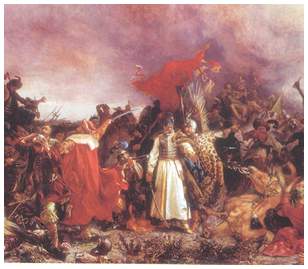
The Cossack incursions continued and the Sultan
sent a force under Iskander Pasha into Poland. Zolkiewski met them
near Kamieniec Podolski and on 28th September 1618 drove them back
with heavy losses. The Busza agreement was reaffirmed while the
Poles expanded the Cossack register and increased the annual subsidy
to them in an attempt to maintain their loyalty to the crown and
to stop their attacks on Turkey. But these volatile frontiersmen
did not remain loyal for long and opened negotiations with Muscovy.
The 30 years war had begun and
although Zygmunt sympathised with the Hapsburgs he was forbidden
by the Sejm to send Polish assistance. Instead he arranged private
recruitment through his own purse and a large force of Poles and
Cossack adventurers crushed Bethlen Gabor's forces in November 1619
and raised the siege of Vienna. Unfortunately this unofficial aid
to the Hapsburgs in Transylvania and Hungary drew Poland into conflict
with Turkey, and the Hapsburgs were not going to provide any help
in return.
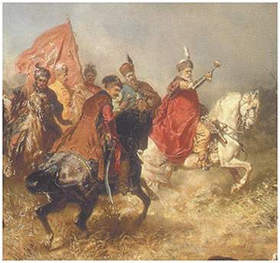 A
Turkish army invaded Moldavia to remove the Hospodar Gratiani, who
had Polish sympathies, and he appealed for Polish assistance declaring
he would provide 25,000 of his own forces. In early September 1620
the Royal Grand and Field Hetman's Zolkiewski and Koniecpolski assembled
8,000 men and marched south, however when Gratiani arrived he had
but 600 men. At Cecora
(18 September to 6th October 1620), on the river Prut, Zolkiewski
met the 22,000 strong Moslem army of Iskanderbasha, withstanding
repeated attacks during September 1620. On 29th September he ordered
a retreat and for 8 difficult days discipline held despite enemy
attacks. On approaching the Polish border discipline of much of
the army melted and the small force was cut to pieces. Zolkiewski
was killed and his head sent to the Sultan, while Koniecpolski was
captured. A
Turkish army invaded Moldavia to remove the Hospodar Gratiani, who
had Polish sympathies, and he appealed for Polish assistance declaring
he would provide 25,000 of his own forces. In early September 1620
the Royal Grand and Field Hetman's Zolkiewski and Koniecpolski assembled
8,000 men and marched south, however when Gratiani arrived he had
but 600 men. At Cecora
(18 September to 6th October 1620), on the river Prut, Zolkiewski
met the 22,000 strong Moslem army of Iskanderbasha, withstanding
repeated attacks during September 1620. On 29th September he ordered
a retreat and for 8 difficult days discipline held despite enemy
attacks. On approaching the Polish border discipline of much of
the army melted and the small force was cut to pieces. Zolkiewski
was killed and his head sent to the Sultan, while Koniecpolski was
captured.
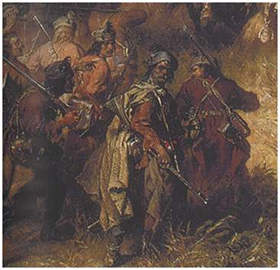 The
following year a massive Turkish army of over 100,000 men invaded
Poland, led by Sultan Osman II. However the disaster at Cecora finally
aroused the Polish nobles and a large force was assembled. The 25,000
Poles and 20,000 Zaporozhian Cossacks led by Chodkiewicz and Lubomirski
were besieged at Chocim
(2 September to 9 October 1621). After over 40,000 losses the
Turks gave up and returned home. Polish losses were also high and
included Chodkiewicz. An honorable peace was agreed based upon Busza. The
following year a massive Turkish army of over 100,000 men invaded
Poland, led by Sultan Osman II. However the disaster at Cecora finally
aroused the Polish nobles and a large force was assembled. The 25,000
Poles and 20,000 Zaporozhian Cossacks led by Chodkiewicz and Lubomirski
were besieged at Chocim
(2 September to 9 October 1621). After over 40,000 losses the
Turks gave up and returned home. Polish losses were also high and
included Chodkiewicz. An honorable peace was agreed based upon Busza.
1624 Tartar
Attack
In June 1624 an invading Tartar czambul
setup its kos
near Przemysl and commenced its raids on the locality. Small Polish
forces did their best to limit the Tartars attacks and in mid June,
as larger forces were gathering against them the Tartars began their
return. On 19th June 1624 they were caught by Koniecpolski as they
crossed the Dniestr near Martynow
and the next day they were decisively defeated.
1617-1629 War
with Sweden
While Poland was preoccupied in the South Gustavus Adolphus renewed
the dynastic conflict with Zygmunt. In 1617, in Livonia, he had
taken Dynemunt (Dunamunde) and Parnawa (Pernau). In 1621 he took
Riga and the following year forced the Lithuanians to sign a truce.
Gustavus Adolphus had desire
for further aggression and in July 1625 he completed his conquest
of Livonia. The following year he targeted Poland directly. He landed
in East Prussia, with the support of the Elector of Brandenburg,
surprising the Poles and taking all the coastal towns, bar Gdansk.
At Gniew
(22-30 September 1626) he defeated a Polish army led by the
inexperienced Zygmunt. Royal Grand Hetman Koniecpolski took over
the Polish 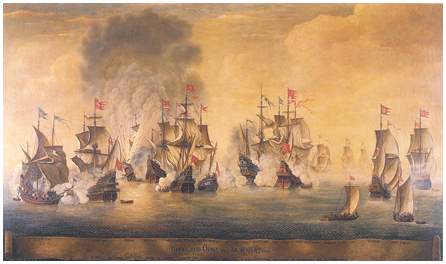 forces
and fought Gustavus to something of a stalemate, with Gustavus avoiding
open battle on a number of occasions. He recaptured Puck on 2nd
April but received a reversal at Tczew
(18 September 1627), though with Gustavus being seriously wounded
the Swedes retreated. Due to Gustavus' skillful maneuvering Koniecpolski
had to resort to a campaign of harassment, which was quite successful
at impeding Swedish offensive operations. At sea the fleet of 9
Polish privateers defeated the Swedish fleet at Oliwa
on 17 November 1627. forces
and fought Gustavus to something of a stalemate, with Gustavus avoiding
open battle on a number of occasions. He recaptured Puck on 2nd
April but received a reversal at Tczew
(18 September 1627), though with Gustavus being seriously wounded
the Swedes retreated. Due to Gustavus' skillful maneuvering Koniecpolski
had to resort to a campaign of harassment, which was quite successful
at impeding Swedish offensive operations. At sea the fleet of 9
Polish privateers defeated the Swedish fleet at Oliwa
on 17 November 1627.
In April 1628 Gustavus Adolphus
returned, but the war had become a war of maneuver with neither
side willing to face the other without advantages of terrain or
fortifications. Koniecpolski was always attempting to catch the
Swedes off guard and at Trzciana
(25 June 1629) he succeeded and Gustavus Adolphus was forced
to sacrifice almost all his cavalry to protect his infantry. The
Sejm, however, preferred to buy the Swedes off with the Treaty of
Altmark (26 September 1629). In it the Swedes kept a number of coastal
towns, which they used as a base for entering the Thirty Years War,
and also received 3.5% of the trade through Gdansk which financed
the Swedes in Germany. Its terms make it clear who the victor was
despite all of Koniecpolski's efforts with inadequate forces. However
Gdansk had not been taken and Gustavus' biographer, Harte, noted
Adolphus was furious "that a pacific
commercial rabble should beat a set of illustrious fellows, who
made fighting their profession".
1630 Cossack Rebellion
In May 1630 Koniecpolski defeated a Cossack rebellion, surrounding
the rebels at 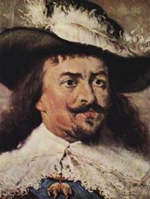 Pereiaslav. Pereiaslav.
Zygmunt
died on 30th April 1632
less than a year after his beloved queen.
His son Wladyslaw IV, aged 37, was elected King
and his coronation took place on 6th February 1633.
1632-1634 War
with Muscovy
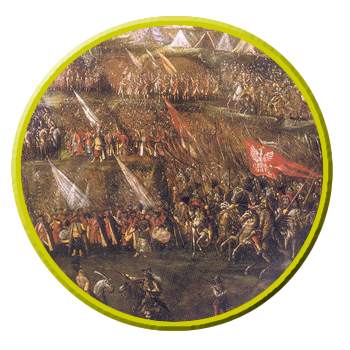 With
the death of Zygmunt, the Tsar decided it would be an excellent
opportunity to take Smolensk
and he sent Michal Sheyn, commander of the Smolensk garrison in
1609-11, with 25-32,000 men. It was not until September of the following
year that a Polish relief force of 20-25,000 men arrived. On 23
September the Russians were forced to break off the siege and were
themselves besieged. On the 25 February 1634 the remaining 12,000
Russians and mercenaries capitulated. The Eternal Treaty was signed
on 14 June 1634 and repeated the territorial provisions agreed at
Deulina while Wladyslaw renounced his claims to Tsar. This was the
first war in which Poland relied on western tactics, using large
numbers of pike & shot infantry and dragoons. With
the death of Zygmunt, the Tsar decided it would be an excellent
opportunity to take Smolensk
and he sent Michal Sheyn, commander of the Smolensk garrison in
1609-11, with 25-32,000 men. It was not until September of the following
year that a Polish relief force of 20-25,000 men arrived. On 23
September the Russians were forced to break off the siege and were
themselves besieged. On the 25 February 1634 the remaining 12,000
Russians and mercenaries capitulated. The Eternal Treaty was signed
on 14 June 1634 and repeated the territorial provisions agreed at
Deulina while Wladyslaw renounced his claims to Tsar. This was the
first war in which Poland relied on western tactics, using large
numbers of pike & shot infantry and dragoons.
1632-1633 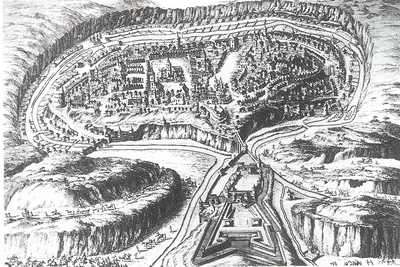
War with Tartars and Turks
During the Muscovite war Tartar incursions had struck in 1632 and
1633. Grand Royal Hetman Koniecpolski defeated a force at Sasowy
Rog in July 1633 and in October he successfully withstood a combined
Turkish-Tartar force at Kamieniec
Podolski.
1635 Armed demonstration
against the Swedes
In the north with the approach of the end of the Treaty of
Altmark Wladyslaw prepared for war raising an army and a fleet in
Prussia to eject the occupying Swedes. The Swedes
busy in the 30 Years war, agreed to leave the towns in exchange
for conformation of their hold on Livonia (Treaty of Stumska Wies,
12 September 1635).
1635-1638 Cossack Rebellions
Meanwhile in the Ukraine the Poles built a fortress at Kudak to
improve their control of the area, but this led to a series of Cossack
rebellions in the years 1635 to 1638, which were all suppressed.
1644 Tartar
Attack
A major Tartar incursion in 1644 was met by Koniecpolski near Ochmatow
(30 January 1644) as it entered Polish territory and was decisively
defeated. It was the most complete defeat of the Tartars by anyone
up till that time and was the more spectacular because it was a
fresh unladen Tartar army that had been crushed.
1638 to 1648 were called the
ten years of Golden Peace when the Republic had, Tartar raids excluded,
peace along all its borders. But it was a false peace - the calm
before the storm.
 4 4

|

![]()

 A
Turkish army invaded Moldavia to remove the Hospodar Gratiani, who
had Polish sympathies, and he appealed for Polish assistance declaring
he would provide 25,000 of his own forces. In early September 1620
the Royal Grand and Field Hetman's Zolkiewski and Koniecpolski assembled
8,000 men and marched south, however when Gratiani arrived he had
but 600 men. At
A
Turkish army invaded Moldavia to remove the Hospodar Gratiani, who
had Polish sympathies, and he appealed for Polish assistance declaring
he would provide 25,000 of his own forces. In early September 1620
the Royal Grand and Field Hetman's Zolkiewski and Koniecpolski assembled
8,000 men and marched south, however when Gratiani arrived he had
but 600 men. At  The
following year a massive Turkish army of over 100,000 men invaded
Poland, led by Sultan Osman II. However the disaster at Cecora finally
aroused the Polish nobles and a large force was assembled. The 25,000
Poles and 20,000 Zaporozhian Cossacks led by Chodkiewicz and Lubomirski
were besieged at
The
following year a massive Turkish army of over 100,000 men invaded
Poland, led by Sultan Osman II. However the disaster at Cecora finally
aroused the Polish nobles and a large force was assembled. The 25,000
Poles and 20,000 Zaporozhian Cossacks led by Chodkiewicz and Lubomirski
were besieged at  forces
and fought Gustavus to something of a stalemate, with Gustavus avoiding
open battle on a number of occasions. He recaptured Puck on 2nd
April but received a reversal at
forces
and fought Gustavus to something of a stalemate, with Gustavus avoiding
open battle on a number of occasions. He recaptured Puck on 2nd
April but received a reversal at 
 With
the death of Zygmunt, the Tsar decided it would be an excellent
opportunity to take
With
the death of Zygmunt, the Tsar decided it would be an excellent
opportunity to take 